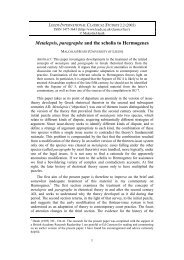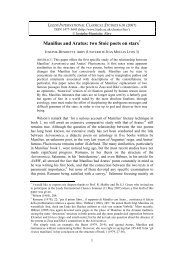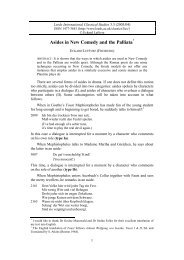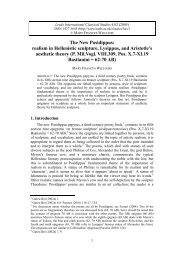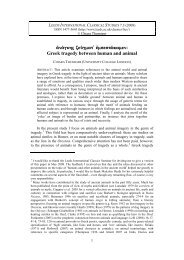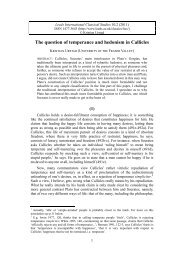Revisiting Tarpeia's myth in Propertius (IV, 4) - Leeds International ...
Revisiting Tarpeia's myth in Propertius (IV, 4) - Leeds International ...
Revisiting Tarpeia's myth in Propertius (IV, 4) - Leeds International ...
Create successful ePaper yourself
Turn your PDF publications into a flip-book with our unique Google optimized e-Paper software.
MYRTO GARANI, REVISITING TARPEIA’S MYTH IN PROPERTIUS (<strong>IV</strong>, 4)<br />
to Varro as a source for Tarpeia’s <strong>myth</strong>, the latter could also be considered as a<br />
possible source for Vesta’s atypical deed. The equation of Vesta with other female<br />
goddesses is also found <strong>in</strong> Ennius’ Euhemerus (cf. Lactantius Div. Inst. I.13, 14). 17<br />
It should be borne <strong>in</strong> m<strong>in</strong>d for the discussion to follow that Ennius has<br />
appropriated with<strong>in</strong> his work various elements of Empedocles’ doctr<strong>in</strong>e. To<br />
mention just a few examples, Ennius’ dream of Homer <strong>in</strong> Annales 1, <strong>in</strong> which the<br />
latter remembers that he became a peacock before his soul passed <strong>in</strong>to Ennius (fr.<br />
11 Sk.), shows close aff<strong>in</strong>ity with Empedocles’ account of the transmigration of<br />
souls. The Empedoclean four elements appear to be the model for Annales 7 (fr.<br />
220 Sk.). 18 As far as Varro is concerned, his association with Pythagoreanism<br />
should also be taken for granted; accord<strong>in</strong>g to Pl<strong>in</strong>y, his burial conformed to the<br />
‘Pythagorean style’ <strong>in</strong> a clay coff<strong>in</strong> with leaves of myrtle, olive and black poplar<br />
(Pl<strong>in</strong>y Nat. Hist. 35.160). In a similar ve<strong>in</strong>, his book entitled Hebdomades or On<br />
Portraits began with a praise of the number seven <strong>in</strong> the Pythagorean style. 19 In<br />
l<strong>in</strong>e with these, we may claim that <strong>in</strong> both Ennius’ and Varro’s works, the process<br />
of Vesta’s assimilation with Venus has plausibly taken place under<br />
Neopythagorean/Empedoclean <strong>in</strong>fluence. What is more, with<strong>in</strong> this tradition<br />
Venus was considered the embodiment of the Empedoclean power of creation, as<br />
she is notably sketched <strong>in</strong> Lucretius’ proem to his first book (DRN 1.1-49). 20<br />
At the same time, to dispute Vesta’s presence <strong>in</strong> this context is to take no heed<br />
of the ambiguities that are <strong>in</strong>herent <strong>in</strong> her character, which <strong>Propertius</strong> appears to<br />
be conscious of and exploits. The contradictions <strong>in</strong> the cult of Vesta have been<br />
variously discussed. 21 As Miller and Platter remark <strong>in</strong> connection with the<br />
presence of Vesta with<strong>in</strong> the elegy <strong>in</strong> question: ‘does Roman religious thought<br />
truly portray the doma<strong>in</strong> of the Vestals as <strong>in</strong>tr<strong>in</strong>sically opposed to the fertility and<br />
sexual activity represented by Venus?’ 22 At this po<strong>in</strong>t we should turn aga<strong>in</strong> to<br />
<strong>Propertius</strong>’ elegy <strong>IV</strong>.1A (l<strong>in</strong>e 21):<br />
Vesta coronatis pauper gaudebat asellis;<br />
Vesta was poor and rejoiced <strong>in</strong> garlanded asses<br />
In these verses the poet refers to the Vesta of early Rome, the patroness of<br />
bakers and their donkeys. Henceforth, Vesta was associated with the millers who<br />
quod, cum tantum honoris et quasi castitatis igni tribuer<strong>in</strong>t, aliquando Vestam non erubescunt<br />
etiam Venerem dicere? / Who, <strong>in</strong>deed, could tolerate the fact that although they have attributed so<br />
much honour and, as it were, chastity to fire, they sometimes do not blush to say that Vesta is also<br />
Venus? (translated by Green).<br />
17<br />
For Ennius’ Euhemerus see Courtney (1999) 27-39, especially fr. III (Vahlen) with commentary<br />
31-2.<br />
18<br />
For Ennius’ Empedoclean Discordia taetra <strong>in</strong> Annales 7 (frs. 225-226 Sk.) or the Paluda virago<br />
(fr. 220 Sk.) see p.8 below. Ennius’ Neopythagorean Epicharmus also began with a reference to a<br />
prophetic dream, <strong>in</strong> which the narrator expounds an account of cosmology (cf. especially<br />
Epicharmus frs. 1, 2, 7 Vahlen). For Ennius’ Epicharmus see Kahn (2001) 87-9; Dutsch<br />
(forthcom<strong>in</strong>g).<br />
19<br />
For Varro’s Pythagoreanism see Kahn (2001) 88-9. For Varro and Empedocles see Deschamps<br />
(1986).<br />
20<br />
For Empedoclean Venus <strong>in</strong> Lucretius see Garani (2007a) 34-43.<br />
21<br />
On Vesta’s ambiguous sexual identity see Beard (1980) and (1995).<br />
22<br />
Miller-Platter (1999) 449.<br />
5



